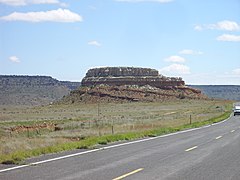| Travesser Formation | |
|---|---|
| Stratigraphic range: late Triassic PreꞒ Ꞓ O S D C P T J K Pg N | |
 Steamboat Butte, showing tilted teds of Travesser Formation in its lower half Steamboat Butte, showing tilted teds of Travesser Formation in its lower half | |
| Type | Formation |
| Unit of | Dockum Group |
| Underlies | Sloan Canyon Formation |
| Overlies | Baldy Hill Formation |
| Thickness | 550 feet (170 m) |
| Lithology | |
| Primary | Siltstone, sandstone |
| Other | Conglomerate |
| Location | |
| Coordinates | 36°56′N 103°29′W / 36.93°N 103.48°W / 36.93; -103.48 |
| Region | New Mexico |
| Country | United States |
| Type section | |
| Named for | Travesser Creek |
| Named by | Baldwin and Muelberger |
| Year defined | 1959 |
  | |
The Travesser Formation is a geologic formation in northeastern New Mexico, southeastern Colorado, westernmost Oklahoma, and northwestern Texas, particularly in the Dry Cimarron valley. It preserves fossils dating back to the late Triassic period.
Description
The formation is mostly reddish-brown clay-rich siltstone and fine-grained sandstone, with sandstone beds up to 20 feet (6.1 m) thick. The formation also contains conglomerate lenses up to 20 feet (6.1 m). The total thickness of the formation is 550 feet (170 m). The formation unconformably overlies the Baldy Hill Formation and underlies the Sloan Canyon Formation or locally the Exeter Sandstone.
The formation is usually assigned to the Dockum Group. The proposal of Spencer G. Lucas and his collaborators to abandon the Dockum Group, possibly in favor of the Chinle Group, is highly controversial.
Fossils
A fossil phytosaur skull and metoposaurids have been found in the formation.
History of investigation
The formation was first named by Baldwin and Muelberger in 1959. Lucas et al. rejected the assignment of the formation to the Dockum Group and adjusted the lower contact.
See also
References
- ^ Baldwin, Brewster; Muehlberger, W.R. (1959). "Geologic studies of Union County, New Mexico" (PDF). New Mexico Bureau of Mines and Mineral Resources Bulletin. 63–2. Retrieved 27 April 2021.
- ^ Lucas, S.G.; Hunt, A.P.; Hayden, S.N. (1987). "The Triassic System in the Dry Cimarron Valley, New Mexico, Colorado, and Oklahoma" (PDF). New Mexico Geological Society Field Conference Guidebook. 38: 97–117. Retrieved 17 September 2020.
- ^ Ziegler, Kate E.; Ramos, Frank C.; Zimmerer, Matthew J. (2019). "Geology of Northeastern New Mexico, union and Colfax Counties, New Mexico: A Geologic Summary" (PDF). New Mexico Geological Society Field Conference Series. 70 (4): 47–54. Retrieved 1 September 2020.
- Lehman, T.M. (1994). "The saga of the Dockum Group and the case of the Texas/New Mexico boundary fault" (PDF). New Mexico Bureau of Mines & Mineral Resources Bulletin. 150: 37–51. Retrieved 1 September 2020.